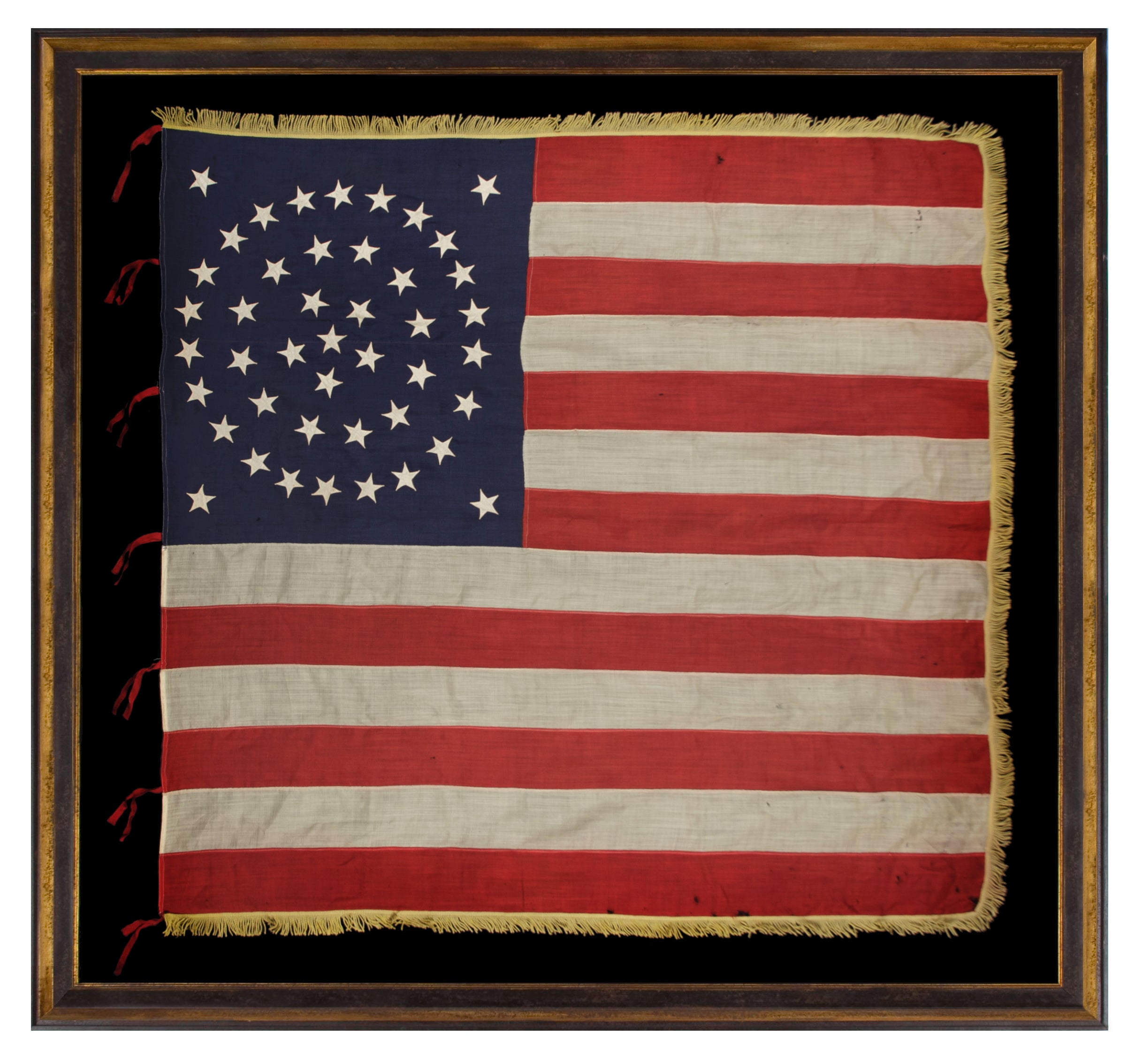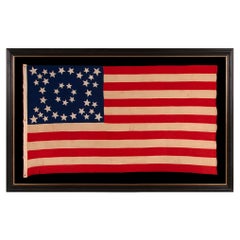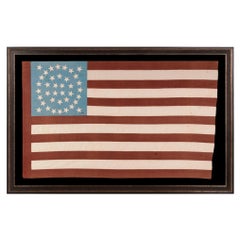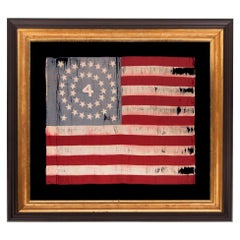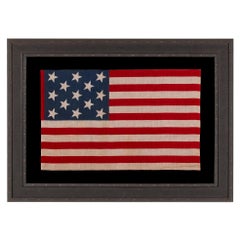About Jeff R. Bridgman American Antiques
As an advisor to top museums and collectors alike, Jeff Bridgman is the world's leading expert and source for antique American flags and political textiles. In this field there are many fakes, forgeries, and misrepresented items, and there is no substitute for experience. As the nation's leading buyer and seller, Jeff R. Bridgman Antiques, Inc. has handled more material than anyone in the field. Jeff has also operated a textile conservation business for 18 years, where expert staff have conservation mounted, framed and restored thousands of examples, more than anyone ...Read More

Established in 19911stDibs seller since 2008
Featured Pieces
Exceptional American Flag, 38 Stars in 3 Sizes in a Fantastic, Unusual Medallion
Located in York County, PA
EXCEPTIONAL ANTIQUE AMERICAN FLAG WITH 38 GLAZED COTTON STARS, IN 3 DIFFERENT SIZES, ARRANGED IN A BEAUTIFULLY GRAPHIC, DOUBLE-WREATH STYLE MEDALLION, WITH TRIANGLES OF 4 STARS IN ...
Category
Antique Late 19th Century North American Political and Patriotic Memorab...
Materials
Wool
38 Star American Flag w/ Extraordinary Features, Colorado Statehood, 1876-1889
Located in York County, PA
38 STAR ANTIQUE AMERICAN FLAG WITH AN EXTREMELY RARE DOUBLE-WREATH CONFIGURATION THAT FEATURES A SQUARE OF FOUR STARS BOTH INSIDE AND OUT, ON A BEAUTIFUL, CORNFLOWER BLUE CANON THAT ...
Category
Antique Late 19th Century North American Political and Patriotic Memorab...
Materials
Cotton
38 Star Antique American Flag; Extremely Rare; Indian Wars, US Army Flank Guidon
Located in York County, PA
RARE AND BEAUTIFUL 38 STAR ANTIQUE AMERICAN FLAG, AN INDIAN WARS PERIOD FLANK GUIDON OF THE 4th U.S. INFANTRY, WITH A MEDALLION CONFIGURATION SURROUNDING THE NUMERAL “4,” AND EXTRAOR...
Category
Antique Late 19th Century North American Political and Patriotic Memorab...
Materials
Silk
13 Star Antique American Parade Flag, ca 1876-1899
Located in York County, PA
13 STAR ANTIQUE AMERICAN PARADE FLAG, WITH A 3-2-3-2-3 CONFIGURATION OF STARS, AN EXTREMELY SCARCE AND UNUSUALLY LARGE VARIETY, MADE circa 1876-1899
13 star American national parade...
Category
Antique Late 19th Century Canadian Political and Patriotic Memorabilia
Materials
Cotton
13 Stars in a Betsy Ross Pattern, ca 1910-1926
Located in York County, PA
13 STARS IN THE BETSY ROSS PATTERN ON A SMALL-SCALE ANTIQUE AMERICAN FLAG MADE SOMETIME BETWEEN APPROXIMATELY 1910 AND THE 1926 SESQUICENTENNIAL OF AMERICAN INDEPENDENCE
13 star fla...
Category
Mid-20th Century Political and Patriotic Memorabilia
Materials
Wool
Votes for Women Parade Textile in Purple and Gren
Located in York County, PA
VOTES FOR WOMEN PARADE TEXTILE IN PURPLE AND GREEN, OF A TYPE WORN AS SASHES AND WAVED AS NARROW PARADE BANNERS, MADE IN HARTFORD, CONNECTICUT BY CALHOUN PRESS FOR THE WOMEN'S POLITI...
Category
Early 20th Century American Political and Patriotic Memorabilia
Materials
Cotton
38 Star Rare Circle in A Square Horstmann Brothers Made American Flag, ca 1876
Located in York County, PA
38 STARS IN A RARE AND STRIKING CIRCLE-IN-A-SQUARE MEDALLION, WITH AN ENORMOUS CENTER STAR, MADE FOR THE 1876 CENTENNIAL CELEBRATION BY HORSTMANN BROTHERS OF PHILADELPHIA, A MAJOR MI...
Category
Antique 1870s Political and Patriotic Memorabilia
Materials
Wool
48 Stars Canted Left and Right in Dancing Stars, ca 1912-1918
Located in York County, PA
48 STARS CANTED TO THE RIGHT AND LEFT IN DANCING ROWS, A RARE VARIETY OF ANTIQUE AMERICAN PARADE FLAG IN A LARGE SCALE, 1912-1918 OR PERHAPS EARLIER, REFLECTS ARIZONA & NEW MEXICO ST...
Category
20th Century American Political and Patriotic Memorabilia
Materials
Cotton
44 Star Antique American Flag, Wyoming Statehood, ca 1890-1896
Located in York County, PA
44 STAR ANTIQUE AMERICAN FLAG WITH AN HOURGLASS ARRANGEMENT ON A DUSTY BLUE CANTON; REFLECTS THE ERA WHEN WYOMING WAS THE MOST RECENT STATE TO JOIN THE UNION, 1890-1896
Wyoming was ...
Category
Antique 1890s American Political and Patriotic Memorabilia
Materials
Wool
Carved Eagle on Circular Plaque, ca 1860-1876
Located in York County, PA
CARVED EAGLE ON A CIRCULAR PLAQUE, IN A VOLUPTOUOUS AND WHIMSICAL STYLE, WITH WINGS REMINISCNET OF THOSE ON TOMBSTONE ANGELS, 3rd QUARTER 19th CENTURY
Diminutive, hand-carved eagle on a circular plaque, found in Maine, with voluptuous form and wings reminiscent of the angels found on early American tombstones. Different than anything I have seen and especially pleasing to the eye, the gold-painted surface is early, save for at the tips of each wing, which I restored due to losses endured between the mid-19th century (likely during the 3rd quarter) and the present. The wood is pine. The carving was formerly part of the personal collection of Maine antiques...
Category
Antique 1860s American Sculptures and Carvings
Materials
Wood
Rare 1876 Centennial Banner with Liberty Bell and Flags
Located in York County, PA
RARE 1876 CENTENNIAL BANNER WITH PATRIOTIC PHRASES, AN EAGLE, CARRYING THE LIBERTY BELL AMIDST TIPPED FLAGS OF 6 NATIONS, AND 13 LARGE, RED STARS, ALL SET WITHIN A BLUE BORDER WITH 3...
Category
Antique Late 19th Century American Political and Patriotic Memorabilia
Materials
Cotton
42 Hand Sewn Stars on An Antique American Flag ca 1889-1890
Located in York County, PA
42 HAND-SEWN STARS ON AN ANTIQUE AMERICAN FLAG WITH A TWO-TONE, DUSTY BLUE CANTON, REFLECTS THE ADDITION OF WASHINGTON STATE, MONTANA, AND THE DAKOTAS, NEVER AN OFFICIAL STAR COUNT, ...
Category
Antique Late 19th Century American Political and Patriotic Memorabilia
Materials
Wool
More About Jeff R. Bridgman American Antiques
